Morocco is home to an impressive 9 UNESCO World Heritage Sites! These sites are dotted throughout the country, from expected places like Marrakesh and Fez, to Tetouan, a relatively untouristed northern city, and on to the desert lands of the Sahara. If you are a lover of history and culture, it makes a lot of sense to use these sites as pillars or totems for your own tour of Morocco.
What is a UNESCO World Heritage Site?
If you already know what a UNESCO World Heritage Site is, skip on to read all about the 9 sites here in Morocco. If you don’t know what a UNESCO World Heritage Site is, it would help you to know that they are selected on the basis of having cultural, historical, scientific or some other form of significance, and they are legally protected by international treaties. Not just anywhere or anything can be a world heritage site! These sites arean important part of the collective interests of our humanity, all around the world. To be listed a country must first take stock of all their ethical and natural properties that are put forward to the International Council on Monuments and Sites and World Conservation Union who make the final decision. To date, there are nearly 1,200 world heritage sites around the world in over 160 different countries!
Morocco’s UNESCO World Heritage Sites
Archeological Site of Volubilis (1997)
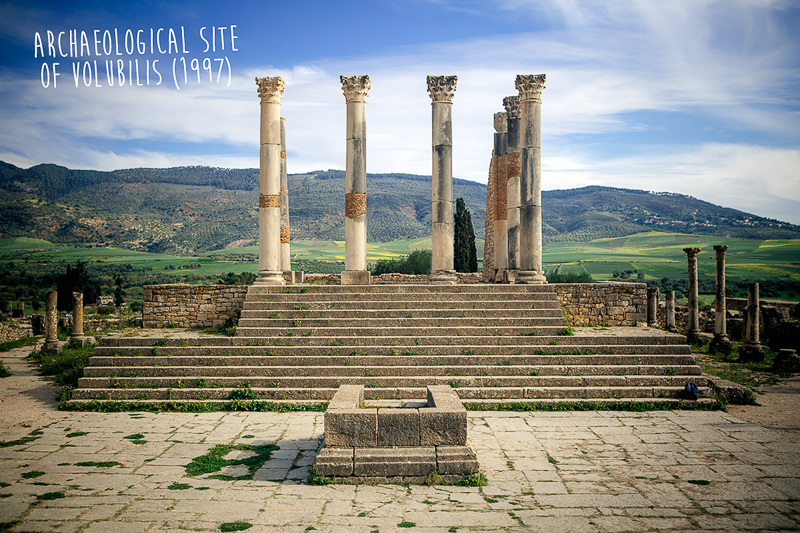
Originally an ancient Berber settlement, Volubilis developed into a Roman dwelling and later became the capital of the region and a major outpost for Roman rule. Located at the foothills of Jbel (Mount) Zerhoun, the site of Volubilis has been home to many civilizations, from prehistoric to the Islamic period (including Libyco-Berber and Mauritanian, Roman, Christian, Arabo-Islamic), several of which have since disappeared. The impressive Roman ruins and surrounding site which still stand amid the fertile terrain were inscribed to the UNESCO World Heritage List in 1997, with a layout and design which reflect the myriad of cultural styles and influences to this day.
Read more about Volubilis in our UNESCO World Heritage Series here:
UNESCO World Heritage Series: Volubilis
Historic City of Meknes (1996)
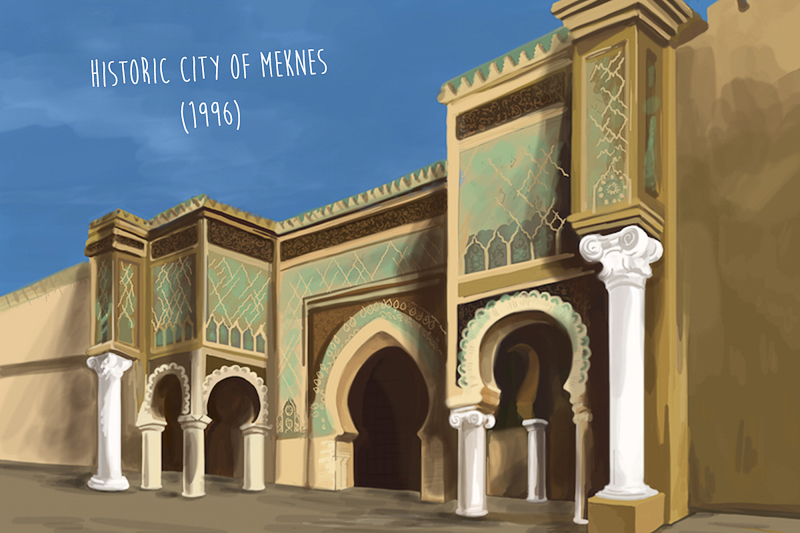
The historic city of Meknes is considered one of the Maghreb’s finest examples of a fortified town, made distinctive by it’s 15m high ramparts which enclose the old city. The northern medina was founded in 1061 AD by the Almoravids and has held influence on the development of civil and military architecture (such as the kasbah) ever since. Inscribed to UNESCO in 1996, the “imperial city” remains differentiated from the Medina by it’s long corridors with towering walls, while the historic monuments, fountains and general urban fabric of the city still represent it’s layout in the 17th century to this day.
Ksar of Ait ben Haddou (1987)
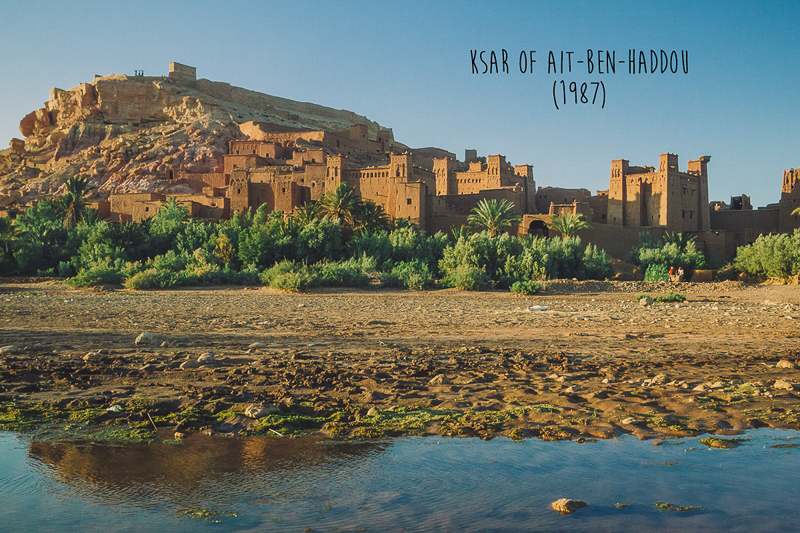
The Moroccan term ‘Ksar’ refers to a group of pisé buildings strategically clustered together and surrounded with defensive walls and corner watch towers. While there are many striking ksar across Southern Morocco, Ait Ben Haddou, located at the foothills of the High Atlas mountains along the old caravan trading route from Marrakesh to the Sahara, is perhaps Morocco’s finest example. The ksar was added to UNESCO’s world heritage list in 1987 and was mainly selected due to the construction remaining to preserve it’s architectural authenticity by illustrating the main elements of a pisé earthen build ksar dating from the 17th Century in Southern Morocco.
Read more about the UNESCO World Heritage Site of Ait Ben Haddou here:
UNESCO World Heritage Series: Ait Ben Haddou
Medina of Fez (1981)
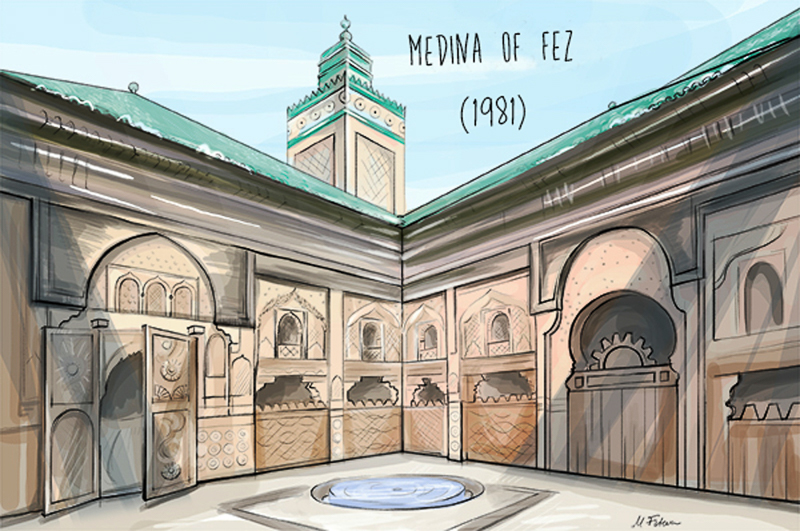
Like Meknes, the general urban fabric and locations of Fez’s fondouks, mosques and fountains still embody what it was like at it’s height, which for Fez was between the 13th and 14th Century. It was founded in the 9th Century and is home to the oldest university in the world, with large sections of the old Medina still remaining pedestrianised due to the winding backstreets and stairways. It is also home to a high concentration of mosaic displays and architecture boasting fine artisanal work, with the Medina echoing the Mediterranean influences of that period. Fez was actually the first historic Medina to be inscribed to the UNESCO World Hertiage list in 1981, pre-dating Marrakesh.
Read more about the important of the Fez medina here:
UNESCO World Heritage Series: Fez
Medina of Essaouira (formerly Mogador) (2001)
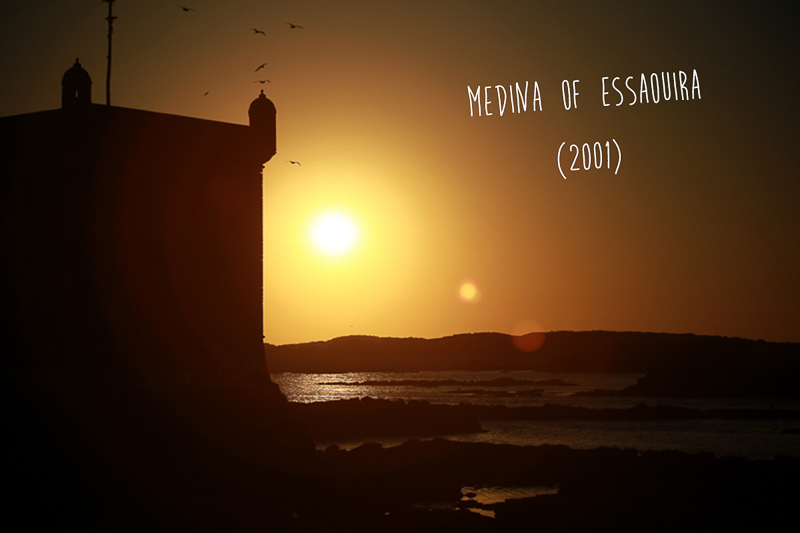
The medina of Essaouira is a younger 18th Century fortified Medina, which was built taking influence from the principles of contemporary European military architecture. It was a highly important port town, once being the major international sea port which linked Morocco to Europe and the rest of the world. The well preserved ramparts and it’s unusual European influences in a North African context made the Medina the perfect candidate for UNESCO and was inscribed to the World Heritage list in 2001. It’s strong European resemblance is credited to a French architect who was heavily influenced by Vauban’s designing of the walled city of Saint-Malo.
Portuguese city of Mazagan (El Jadida) (2004)
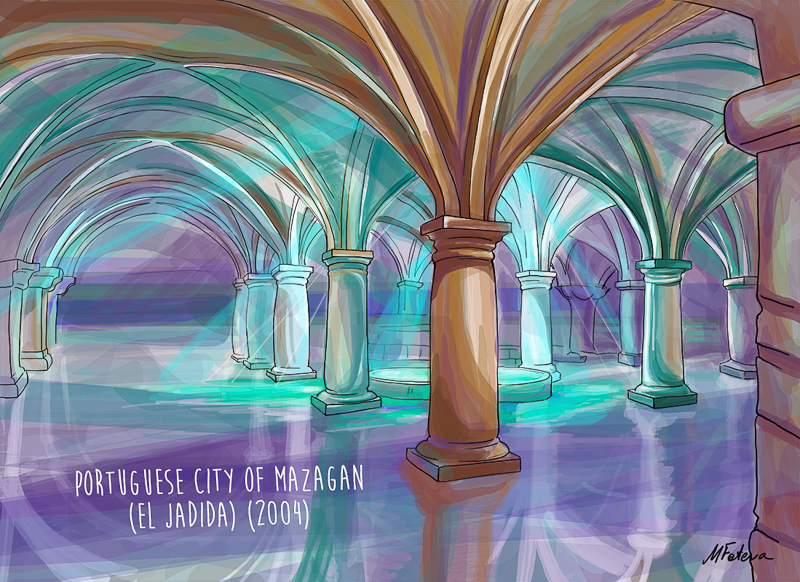
Inscribed to the UNESCO World Heritage list in 2004, the Portuguese city of Mazagan is a fortification that was constructed by Portuguese traders and is today a small part of the coastal city of El Jadida. Finally taken over by Moroccans in 1769, the ramparts and fortification resemble early renaissance military design, while the cistern (seen illustrated above) and the Church of Assumption resemble gothic architecture built in a style reflecting typical Manueline characteristics. As one of the first settlements built by Portuguese explorers en route from West Africa to India, the fortification is considered a pristine example of the exchanges of culture and influence between Morocco and Europe from the 16th to 18th centuries.
Medina of Marrakesh (1985)
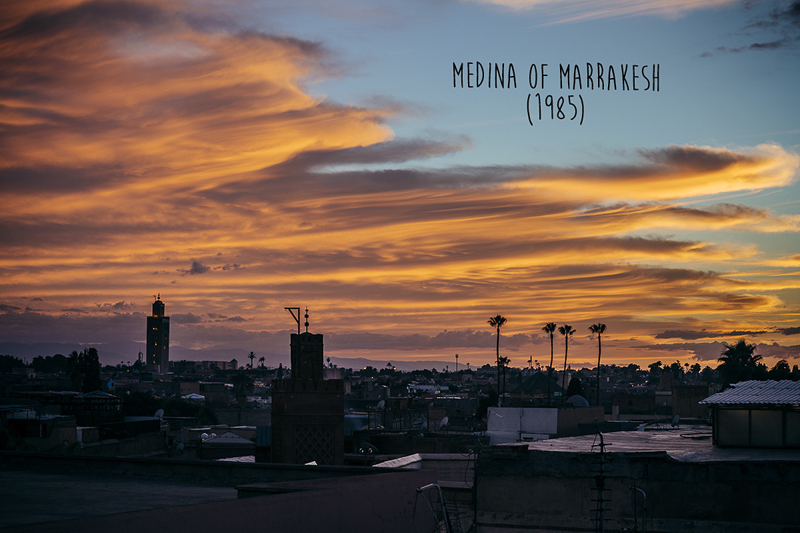
Long the political, cultural and economical hub of the Western Muslim world, Marrakesh was founded by the Almoravids in 1070-72. The city contains many important and spectacular historical and cultural sites, such as the Koutoubia Mosque and Jamaa El Fna, North Africa’s largest square. The second Medina to be inscribed to UNESCO (in 1985), the red city is also home to many of the countries finest examples of Islamic architecture, such as the Saadian Tombs, as well as historic and elaborate palaces like the Bahia Palace. It’s tangled labyrinth of streets embody an stunning example of a living, historic Medina town.
Read all about Marrakesh world heritage:
Marrakesh UNESCO World Heritage Series
Medina of Tetouan (1997)

Spread across the steep slopes of Jebel Dersa in the northern Rif region, Tetouan had particular importance from the 8th century onwards, serving as a middle ground between Morocco and Andalusia in Southern Spain. It’s strategic positioning nearby to the Strait of Gibraltar was defended by a 5km wall surrounding the Medina, which although is one of the smallest in Morocco, it remains to be one of the most in tact. The town was at one point re-built by Spanish refugees after the Reconquest and the Andalusian influence to it’s urban fabric can be see everywhere inside the medina. The blend of Moroccan and Andalusian influences to it’s culture and architecture compliments the North African mountain backdrop and it is no wonder Tetouan was inscribed to UNESCO’s World Hertiage List in 1997. Like Fez and Marrakesh, the Medina is also home to a high concentration of stunning mosaic and displays of skilled artisanal work.
Rabat, Modern Capital and Historic City (2012)
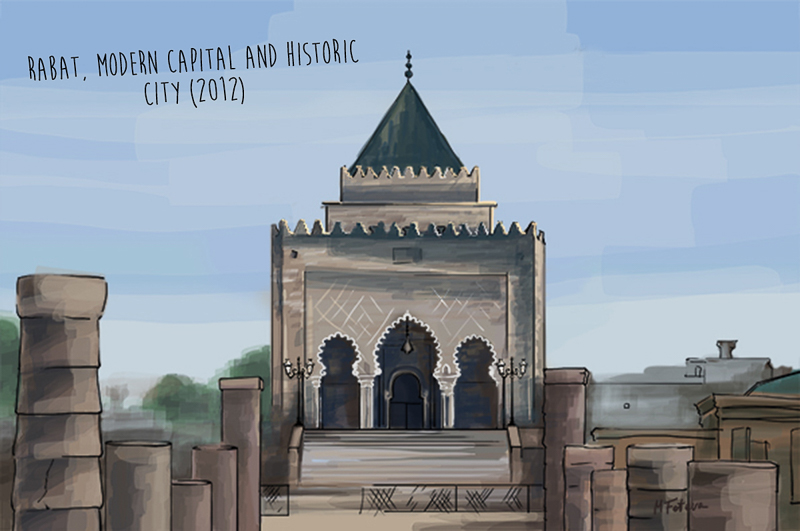
The older parts of Rabat, Morocco’s modern capital date back to the 12th Century, while the modern side of the city first began developing with the French Protectorate from 1912 to the 1930’s. Today, the modern city of Rabat is even considered by UNESCO to be one of the “…largest and most ambitious modern urban projects built in Africa in the 20th Century and probably the most complete.” Located along the North-West of Morocco’s Atlantic coastline, Rabat is an incredible example of the exchanges between it’s Arabo-Muslim past and modern Western influences. The last of Morocco’s to be inscribed to UNESCO’s Word Heritage list, the layout and structure of the modern day Rabat draws large influence from it’s Arabo-Muslim past.
Read all about Rabat and it’s place on the heritage list here:
Rabat UNESCO World Heritage Series
Possible Future UNESCO World Heritage Sites
Could we see more UNESCO sites soon? Here are some of the tentative destinations in Morocco that might make the cut.
- Moulay Idriss Zerhoun Located nearby to Meknes and spread across the slopes of Jebel Zerhoune, Moulay Idriss holds a sacred aspect for many Moroccans; it is the burial place for Moulay Idriss the I who originally brought the religion of Islam to Morocco. The large green tiled mausoleum and mosque is located at the centre of it’s Medina, which is located only 3km away from the UNESCO protected Volubilis Roman ruins.
- Taza and the great Mosque Taza is a northern city in Morocco, nestled between the Rif and Middle Atlas mountains. The great mosque of Taza was built by an Almohad sultan and is one of the oldest remaining examples of Almohad architecture in Morocco. A large chandelier estimated to weigh 3 tonnes is located inside.
- Tinmal Mosque The Tin Mal Mosque lies perched high up in the High Atlas Mountains in the small Berber mountain village of Tin Mal (or Tinmel /Tinmal). It was built by the Almohad dynasty in 1156 and the Koutoubia in Marrakesh was actually modeled on it’s design.
- City of Lixus Lixus is ancient Roman site just outside of Larache, once one of the main coastal strongholds of Roman Mauritania along Morocco’s Atlantic coastline. The ruins include Roman baths, 4th Century walls, mosaic flooring, a Christian Church and the remains of ancient temples.
- El Gour (Souk el Jemaa el Gour) An ancient burial site located 30km south east of Meknes. El Gour is a distinctive type of burial mound known as a Banzina, usually constructed for people of very high status. It is estimated to have been constructed sometime between the 2nd and 4th centuries BCE, although there is very limited research on it’s origins.
- Cave of Taforalt Commonly referred to as the “Grotte des Pigeons,” Taforalt is a prehistoric cave located in the northern Oujda region of Morocco nearby to the village of Taforalt. The cave contains prehistoric archaeological remains, with layers of material and signs of industry which reflect use during the Middle Paleolithic and Epipaleolithic periods.
- Talassemtane National Park A national park in the northern Rif region of Morocco. Part of the ‘Transcontinental Biosphere Reserve of the Mediterranean,’ Talassemtane includes efforts to re-plant fir (which are under threat in Morocco) and the endangered Atlas cedar tree.
- Area of the Dragonnier Ajgal The ‘Ajgal (or Ajmal) Dragon’ is a species of tree which is actually from the same family as asparagus, as well as the Dracaena plant. The ‘Ajgal’ is endemic to Southern Morocco and the Anti Atlas mountain range, with large amounts found along the mountainsides of Jebel Imzi and Jebel Adad Medni, which due to inaccessibility, have created their own remarkable eco-systems of the tree and plant species.
- Lagoon of Khenifiss The largest lagoon along the Moroccan coast and located in the middle of a National Park and a prime spot for birds nesting during migration. Just north of the border with the Western Sahara, the National Route 1 runs through the park, which features a large area of sand dunes meeting up with the Atlantic coastline.
- Dakhla National Park Mostly covered by the expanse of the Sahara Desert and low in vegetation, the Dakhla National Park is also a stunning area where Sahara sand meets the Atlantic sea and another birdwatchers haven. The park engulfs the coastal city of Dakhla, located far south in the Western Sahara under Moroccan control.
- Figuig Oasis Figuig is situated among the far eastern oasis and palmeries of the Sahara, adjacent to the border with Algeria. It is actually surrounded on 3 sides by the Algerian border (which is now closed) and has numerous interesting monuments and historic architecture besides the spectacle of the natural, isolated palmeries, such as prehistoric rock carvings, ancient irrigation channels, historic ramparts and mausoleums for important figures.
- Casablanca, Twentieth-Century City, Crossroads of Influences First settled by Berbers, used as a port town by Romans, bombarded by the Portuguese and occupied by both the Spanish and the French, Casablanca is today the largest city in the Maghreb (and one of the largest in Africa) both economically and demographically.
- The Chaplet of the Tighmert Oasis, Pre-Saharan region of Wad Noun Around 200km south of Agadir and 12km south east of Goulmim,the Oasis of Tighmert was once the captial city of No Lamta, a major medieval capital of the northwestern shores of the Sahara until the 16th Century. The stunning, wild palmeries contain a high volume of stunning ksar and pisé architecture.
Taking in some of these amazing locations is just one reason to come visit Morocco. Whether you want to see history, learning about the local culture, or eat your way across the land we can help plan your next adventure. Send us an email today and let’s start planning!














